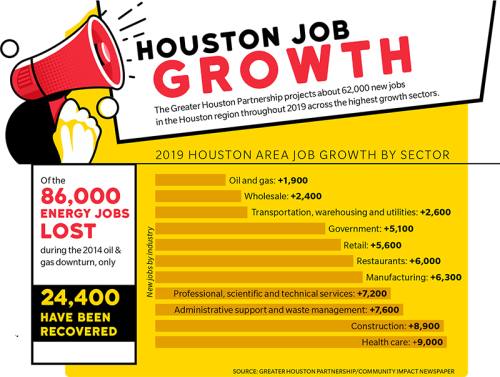The Greater Houston Partnership projects less than 2,000 of the region’s 71,000 new jobs expected to be added in 2019 will come from the oil and gas sector after seeing little job creation in the last year.
Since the oil and gas downturn of 2014, the industry has lost more than 86,000 Houston-area jobs and only regained about 24,400, according to the GHP. Patrick Jankowski, the organization’s senior vice president of research, said Houston survived the downturn by creating jobs elsewhere.
“Houston has emerged from one of the worst energy downturns of the past 35 years where one in every four of the region’s energy jobs was lost,” he said in a statement. “In previous downturns, such a collapse would have devastated the entire economy. This time, Houston held up quite well because our ties to the U.S. and global economies are now just as strong as our ties to oil and gas.”
At the GHP’s annual Economic Outlook Forum in December, Cindy Taylor, president and CEO of Oil States International, said overall job growth this year will be light, even with a moderate rebound in crude oil prices. The majority of oil firms were profitable as of the third quarter of 2018, and crude oil prices are expected to average $65 per barrel in 2019, up from the mid-$50s in November, according to a GHP report.
Taylor said the oil and gas industry is contending with more efficient technologies, reducing the need for new jobs.
“There will be employment gains, but we can’t forget we are doing more with less,” she said. “This is not an issue unique to energy by any means. We are all talking about how do we repurpose our workforce to optimize what we have available with digital technology.”
Tim Hanna, who works in sales for AIV—a Houston-based company that builds and distributes valves and actuators for the oil and gas industry—said he thinks new technology will eventually disrupt the market, but full automation is still in the future.
Hanna said the company avoided laying off more than a handful of employees in the aftermath of the 2014 downturn, and it has grown since. In fact, work is nearing completion on a larger facility near Telge Road and Hwy. 290 in Cy-Fair, he said.
In March, AIV staff will move into the 320,000-square-foot campus, allowing room for more inventory and more employees, Hanna said.
“We’re using technology to our advantage,” he said. “When you’re automating the stuff that we do, you’re putting a guy in the field out of a job.”
While the downstream side of the industry has remained steady in the last couple of years, Hanna said upstream and midstream sectors face uncertainty when it comes to tariffs and the price of oil.
Despite AIV’s success in recent years, he said he thinks it is unlikely the industry as a whole will ever return to where it was before the downturn.
“I don’t think we’re going to see $100 barrels any time soon,” he said. “But you have to find a happy medium. Oil and gas guys love to see barrels priced at $100 and gas at $3 a gallon, but the consumer on the other hand hates it.”
A younger workforce
One challenge that is unique to the oil and gas sector is attracting and retaining workforce—particularly millennials—while fighting the perception of being an anti-environment industry, Taylor said. The solution, she said, might include outsourcing from engineering firms, accepting that the future workforce will be different than the past, and focusing on the positive economic impact the industry brings, even if jobs don’t have high appeal.
At AIV, the average age of employees will drop from the 50s to the 40s in the next few years, Hanna said.
“[The younger generation] wants to use technology and find different ways we can streamline and get better at things,” he said. “If it helps us and makes it easier, we’re all for it. The older generation is a little hesitant about change.”
However, he said the age gap also presents a gap in knowledge and hands-on training. As the industry’s experienced employees retire and the workforce gets younger, there will be growing pains, Hanna said.





